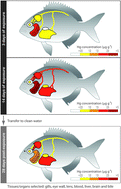A new page on the road book of inorganic mercury in fish body – tissue distribution and elimination following waterborne exposure and post-exposure periods
Abstract
There are several aspects of inorganic mercury (iHg) toxicokinetics in fish that remain undeveloped despite its environmental ubiquity, bioaccumulation capacity and toxicity. Thus, this study presents new information on the uptake, distribution and accumulation of iHg following water contamination by adopting a novel set of body compartments (gills, eye wall, lens, blood, liver, brain and bile) of the white sea bream (Diplodus sargus) over 14 days of exposure. Realistic levels of iHg in water (2 μg L−1) were adopted in order to engender reliable conclusions in the assessment of fish health. A depuration phase of 28 days was also considered with the purpose of clarifying iHg elimination. It was found that iHg was accumulated faster in the gills (within 1 day), which also had the highest accumulated levels among all the target tissues/organs. Moreover, iHg increased gradually with exposure time in all the tissues/organs, except for the lens that showed relatively unaltered levels throughout the experiment. After 14 days of exposure, lower values of Hg were recorded in the brain/eye wall compared to the liver, which is probably related with the presence of blood-organ protection barriers, which limit iHg influx. iHg reached the brain earlier than the eye wall (3 and 7 days, respectively) and, hence, higher accumulated levels were recorded in the former. A depuration period of 28 days did not allow the total elimination of iHg in any of the tissues/organs. Despite this, iHg was substantially eliminated in the gills, blood and liver, whereas the brain and eye wall were not able to eliminate iHg within this timeframe. The brain and eye wall are more “refractory” structures with regard to iHg elimination, and this could represent a risk for wild fish populations.



 Please wait while we load your content...
Please wait while we load your content...